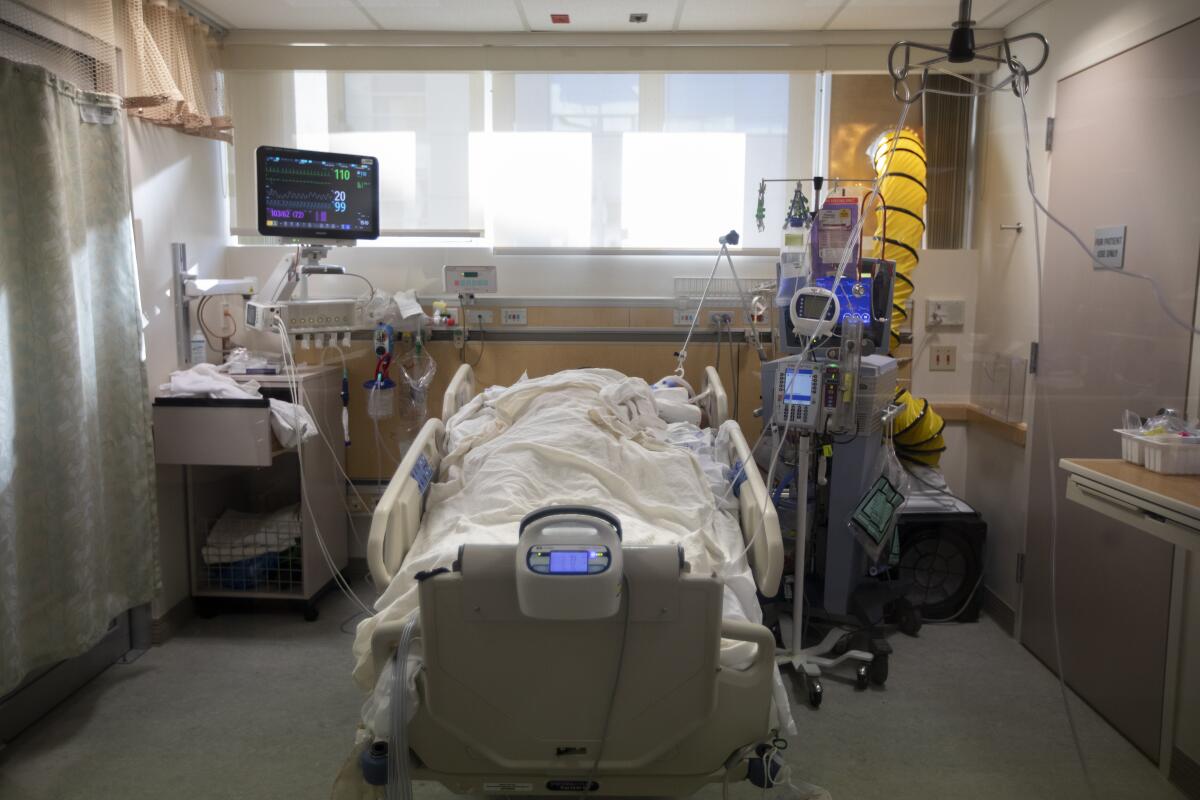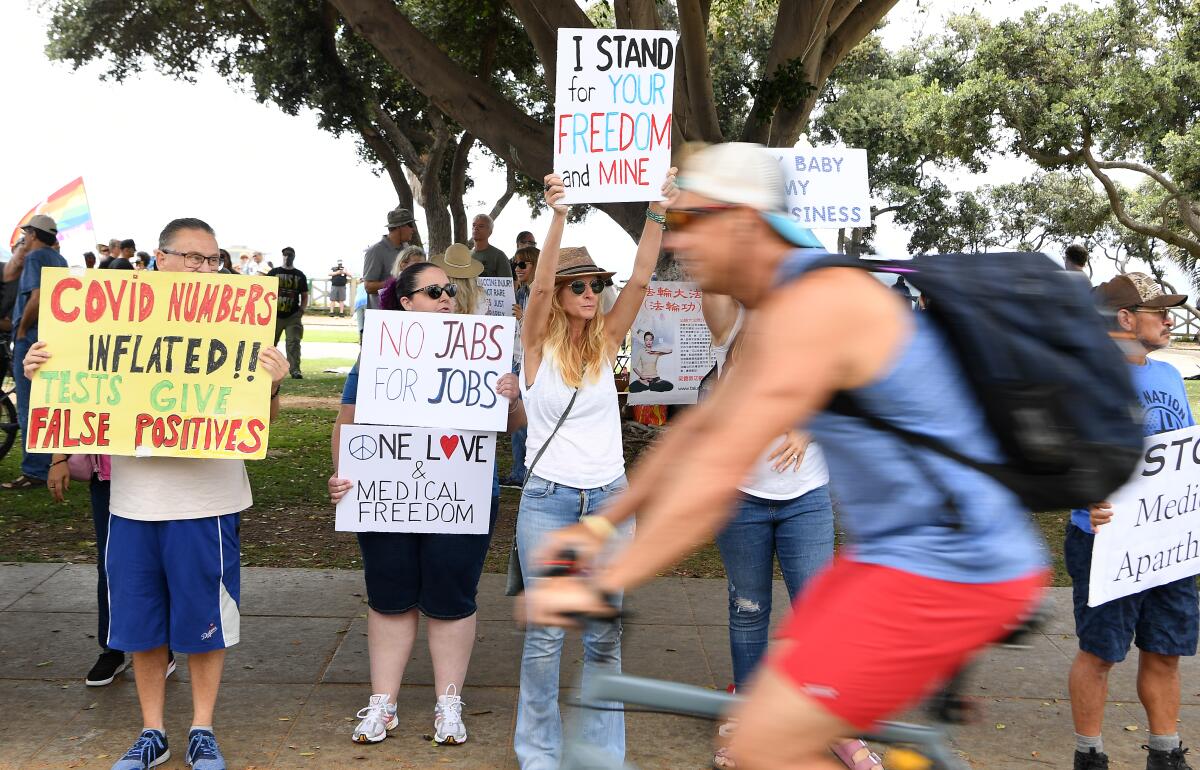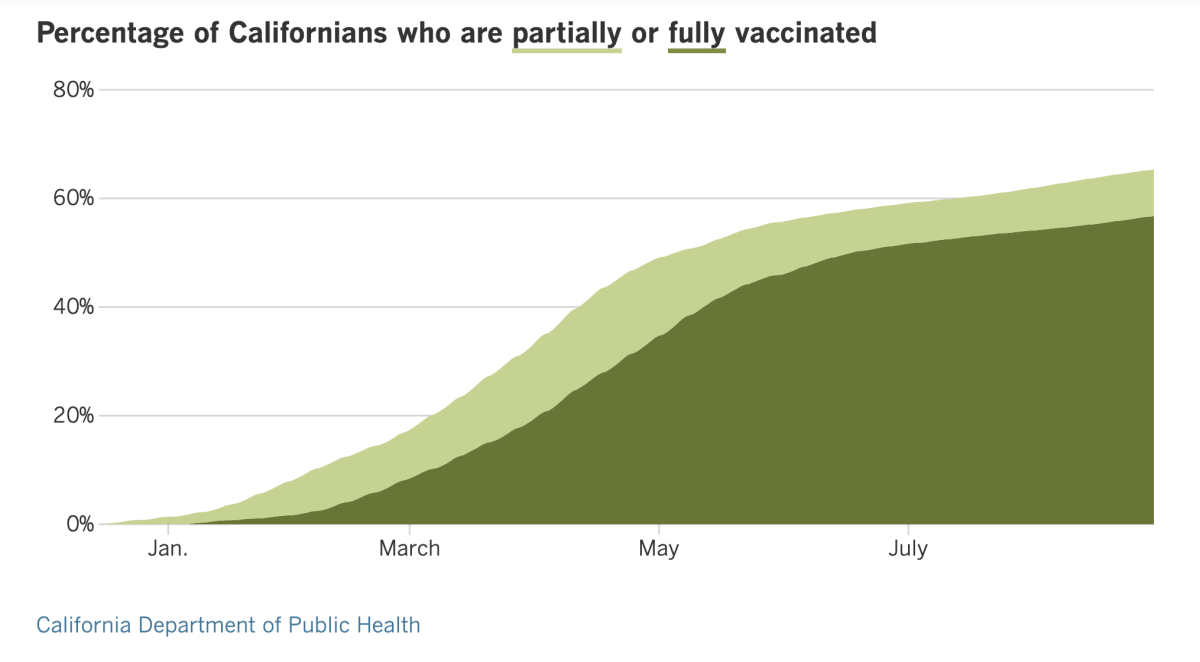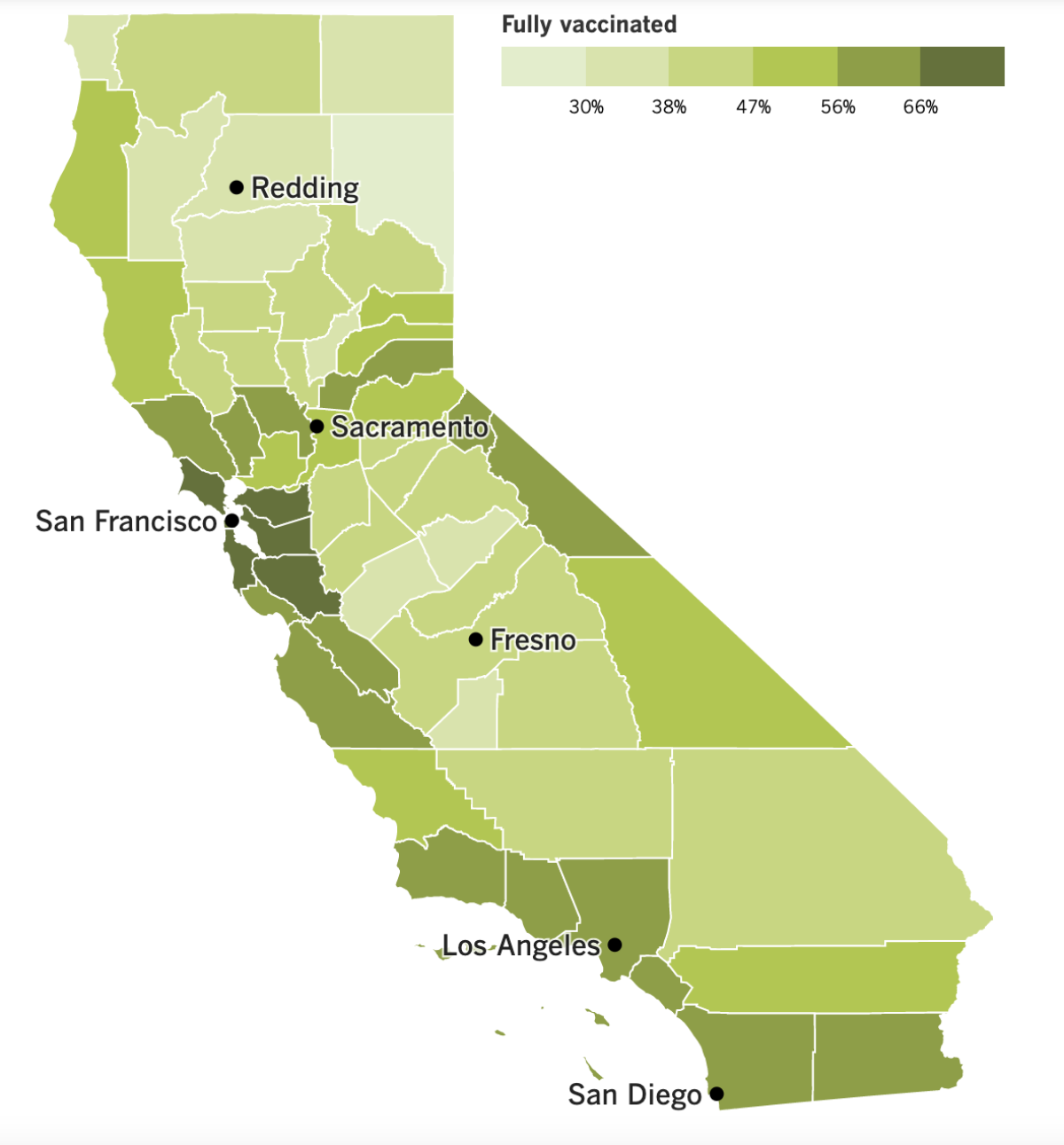Coronavirus Today: What it’s like to die from COVID-19
Good evening. I’m Karen Kaplan, and it’s Tuesday, Aug. 31. Here’s the latest on what’s happening with the coronavirus in California and beyond.
Nearly 40 million Americans have been infected with the coronavirus, and more than 636,000 became sick enough to die. Those numbers are astronomically high, but they still leave well over 290 million of us with no clear idea of what it’s like to have the virus raging inside our bodies.
Karen Gallardo does — not because she’s been sick herself, but because she’s a respiratory therapist who’s been caring for COVID-19 patients at Community Memorial Hospital in Ventura for nearly a year and a half.
In an eye-opening essay, she describes what happens if you develop a serious case of COVID-19, starting with symptoms that are bad enough to bring a patient to the emergency room and ending with his or her very last breath:
Stage 1: You come to the hospital because you’re having trouble breathing on your own. The medical team puts you on supplemental oxygen and admits you to a ward, where you’re given monoclonal antibodies, antivirals or other treatments. If all goes well, your ability to breathe will recover in a few days and you’ll be sent home.
Stage 2: The breathing treatments don’t work and you feel like you’re drowning. You can’t go to the bathroom or even sit up on your own. Doctors transfer you to the intensive care unit.
Stage 3: A machine forces air into your lungs through a bulky face mask wrapped tightly around your face. Even so, the number of breaths you need to take to get your required oxygen leaves you utterly exhausted.

Stage 4: Still unable to get enough oxygen into your body, you are sedated, then paralyzed, so a tube can be threaded into your airway and connected to a ventilator. But first, if you’re lucky, you’ll be able to call your loved ones in case it’s their last chance to hear your voice.
Stage 5: If several days on a ventilator have not turned things around for you, doctors may try to get you on an ECMO machine. These machines will oxygenate your blood for you, bypassing your lungs so they might have a chance to heal. But community hospitals like Gallardo’s don’t have them, and you might not be stable enough for a transfer to one that does.
Stage 6: Now your medical team has its hands full dealing with the consequences of your COVID-19 treatment. Tubes are inserted into your chest cavity to clear out the air that has leaked there. Your kidneys can’t keep up with all the drugs you’ve received, so you may require dialysis. Because you’ve been sedentary you may develop a clot, which could cut off blood flow to vital organs or result in a heart attack or stroke. You may need to be revived with CPR.
Stage 7: If your family decides you have no chance to recover, they’ll have a final FaceTime call with you. The breathing tube will be removed and the ventilator shut off. Someone from the medical team will be there to hold your hand until your breathing stops.
“I’ve been at this for 17 months now,” Gallardo writes. “It doesn’t get easier.”
If this sounds like a situation you’d rather avoid, she has some simple advice: “Get vaccinated.”
The patients she sees who have been vaccinated rarely progress beyond Stage 1.
“If only that were the case for everyone,” she writes.
By the numbers
California cases, deaths and vaccinations as of 4:50 p.m. Tuesday:

Track California’s coronavirus spread and vaccination efforts — including the latest numbers and how they break down — with our graphics.
Does the 1st Amendment protect disinformation about vaccines?
There’s nothing more American than a protest. Our country wouldn’t be here without them, and “the right of the people peaceably to assemble” is enshrined in the very first amendment to the U.S. Constitution.
Hundreds of people exercised that right over the weekend, gathering near the Santa Monica Pier to vent their opposition to COVID-19 vaccines and the growing momentum toward mandating them in various aspects of public life.
One of them was Sharon Kotas, a Santa Clarita resident who said she expects to get fired from her job with the Los Angeles County Department of Children and Family Services for refusing to get vaccinated. Despite reams of evidence that they’re safe and effective, Kotas said she doesn’t believe the shots will actually protect her from getting COVID-19.
“It should be my body, my choice,” she said.
Another protester brandished posters that disparaged the vaccine.
“It’s obvious these vaccinations are a sign of segregation, and that’s a form of tyranny,” said the man, who identified himself as Craig from Huntington Park.

Some protests at vaccination sites have threatened to prevent people who wanted the shots from getting them. Perhaps the most notable example of this occurred in late January, when a group of 40 to 60 demonstrators showed up at Dodger Stadium and forced the Los Angeles Fire Department to close the main entrance for about an hour.
At the time, the stadium was one of the largest mass vaccination sites in the country. Medical personnel administered 5,740 shots that day, at the low end of its usual range of 5,700 to 7,700 doses.
That protest gave rise to California’s Senate Bill 742. If passed, it would prevent protesters from obstructing, intimidating or harassing people at vaccination sites. Violations would be punishable by up to 6 months in a county jail, a fine of up to $1,000, or both.
The bill was drafted by State Sen. Richard Pan (D-Sacramento), a pediatrician and longtime vaccine champion. He has worked to make it more difficult for parents to avoid getting routine childhood vaccinations for their kids, and he’s had it with people who not only refuse to get the COVID-19 vaccine for themselves but are spreading false information to dissuade others as well.
In July, Pan said he volunteered at a vaccine clinic in Sacramento where medical personnel had trouble talking with patients and answering their questions because anti-vaxx protesters were butting in with a bullhorn.
As a public official, he’s used to such behavior. But he fears that vocal — perhaps belligerent — crowds will scare others away, especially those who still feel uneasy about the shots.
People “shouldn’t have to run a gantlet to get vaccinated,” Pan told my colleagues at Kaiser Health News.
Lots of Pan’s legislative colleagues seem to agree with him. It has passed in the state Senate and is now in the hands of the Assembly, where the Appropriations Committee has endorsed it. To become law, it’ll have to clear both houses before the Legislature adjourns on Sept. 10.
But even if it does, it might not withstand a legal challenge.
Eugene Volokh, a professor of 1st Amendment law at UCLA, warns that the bill “is clearly unconstitutional.”
Volokh says there are two problems. One is that the bill is too expansive in its definition of harassment — it prohibits protesters from coming within 30 feet of a person to try to talk to them, chant or sing at them, hand them a leaflet or hold up a sign.
Similar laws protect patients at abortion clinics, but they feature smaller buffer zones. A Supreme Court ruling in 2000 allowed for an 8-foot “bubble zone” around a person going into or out of a clinic. However, a subsequent ruling in 2014 overturned a law that established a 35-foot “buffer zone” around the clinics themselves.
The second problem Volokh sees is that the bill only addresses speech about vaccines but would allow protests against a war, for instance, or animal abuse. That kind of targeting violates the 1st Amendment, he said.
Glen Smith, the litigation director for the First Amendment Coalition, praised the bill for going after people who would prevent someone from getting vaccinated. But requiring protesters to stay 30 feet away “seems to be overkill for me,” he said.
On the other hand, the bill passes muster with the American Civil Liberties Union, a staunch supporter of 1st Amendment rights. Allowing people to get vaccinated in peace is a worthy reason to limit protesters’ freedom of expression, said Kevin Baker, director of governmental relations at ACLU California Action.
That’s how Pan sees it.
“This law doesn’t say you can’t protest,” he said. “Especially as we’re trying to deal with this pandemic, we need to do what we can to be sure people feel safe getting themselves vaccinated.”
California’s vaccination progress


See the latest on California’s vaccination progress with our tracker.
Consider subscribing to the Los Angeles Times
Your support helps us deliver the news that matters most. Become a subscriber.
In other news ...
Congratulations, California! More than 80% of us who are eligible to be vaccinated against COVID-19 — that is, those of us who are 12 or older — have now received at least one shot, according to data from the U.S. Centers for Disease Control and Prevention.
That partial-vaccination rate of 80.6% is good enough to rank ninth among the states and put us ahead of other large states like Pennsylvania (80%), New York (78%), Florida (73.1%) and Texas (68.6%). Gov. Gavin Newsom said that crossing the 80% mark was a “momentous occasion.”
But we’re hardly out of the woods. There are sizable disparities by race and geography. For instance, 11 of the state’s 58 counties have at least partially vaccinated more than 70% of their residents, but in 16 other counties, fewer than half have gotten even one shot. (In Los Angeles County, 74% of vaccine-eligible residents are partially or fully vaccinated.)
And only about half of all Black and Latino residents are at least partially vaccinated, compared with 61% of white residents, 63% of Native Americans and 75% of Asian or Pacific Islander residents, according to our vaccine tracker. (Keep in mind that racial and ethnic data for about 15.3% of vaccinated people are unknown, so these figures are an undercount.)
Some of those disparities might have been reduced with the help of a statewide vaccine mandate, but Democratic lawmakers in Sacramento have dropped that controversial idea.
The plan developed by Assemblywoman Buffy Wicks (D-Oakland) had called for Californians to show proof of vaccination in order to gain entry to many indoor businesses, according to drafts of a bill that were leaked last week. Workers in both the public and private sector would have had to be fully vaccinated or submit to regular coronavirus testing.
Wicks said Monday that she’s no longer pursuing the proposal this year. That effectively leaves any decision about a statewide vaccine mandate in the hands of Newsom, who is two weeks away from a recall election driven in large part by opposition to policies aimed at limiting coronavirus spread.
Wicks may have tabled the idea, but the union representing L.A. teachers is picking it up. United Teachers Los Angeles is calling for a vaccine mandate — for students.
UTLA wants students “to achieve full vaccination no later than 12 weeks following the birthday in which they become eligible.” Right now that would be their 12th birthday, but federal regulators are expected to authorize COVID-19 vaccines for children as young as 5 in the coming months.
Students could still be exempted from the mandate if they have legitimate medical or religious reasons.
Teachers and other employees of L.A. Unified must be vaccinated by Oct. 15.
A new study helps explain the urgency to get more people vaccinated. Research from England’s public health service confirms that the Delta variant not only spreads more readily than the Alpha variant it rapidly overtook, it’s also making unvaccinated people sicker.
Researchers examined the health records of more than 43,000 Britons who tested positive for coronavirus infections between March 29 and May 23 and whose viral specimens were genetically sequenced to determine which variant had infected them. Through most of April and May, unvaccinated people who contracted the Delta variant were more than twice as likely to be admitted to hospitals than were unvaccinated people who caught Alpha, which was first identified in the United Kingdom.
The study — considered the largest and most detailed accounting to date of Delta’s impact on the pandemic — also found that among unvaccinated people, those infected with Delta were more likely to go to a hospital emergency room than those infected with Alpha.
While we’re across the pond: The European Union has recommended that its 27 member nations reinstate restrictions on tourists from the U.S., reversing a decision in June that suggested lifting restrictions on American travelers as summer vacations got underway.
The new advice was prompted by the rising rates of coronavirus infections in the U.S. EU member countries still have the option of welcoming American travelers who are fully vaccinated, however.
Back at home, the CDC is warning Americans not to take ivermectin, a drug that has been embraced by anti-vaxxers despite a lack of sound scientific evidence that it does anything to prevent or treat COVID-19.
The drug is used to treat parasitic infections, often in animals. Before the pandemic, outpatient pharmacies dispensed 3,600 prescriptions a week. By early August, that figure had ballooned to more than 88,000 prescriptions a week, the CDC said.
Humans also have been buying it online without a prescription, including formulations for horses, sheep, cattle and other large animals that “can be highly concentrated and result in overdoses when used by humans,” the CDC added.
And sure enough, the number of calls about ivermectin coming in to poison control centers was five times higher in July than it was before the pandemic. ER visits and hospital admissions tied to the drug are up as well, the CDC said.
The Food and Drug Administration backed up its sister agency with a memorable tweet: “You are not a horse. You are not a cow. Seriously, y’all. Stop it.”
Your questions answered
Today’s question comes from readers who want to know: What happens if my child tests positive for a coronavirus infection at school?
If your child attends a school in L.A. County, he or she will be offered a surgical mask (if they don’t have one already). Then they’ll be escorted to an isolation space and remain there until they can return home.
The L.A. County Department of Public Health says that people with COVID-19 should isolate at home for 10 days after their first symptoms appear or they test positive.
Meanwhile, the school will work with health officials to figure out who has been in close contact with your child.
Exactly what qualifies as close contact may vary from place to place. The Centers for Disease Control and Prevention defines it as “someone who was within 6 feet for a total of 15 minutes or more within 2 days prior to illness onset, regardless of whether the contact was wearing a mask.”
L.A. Unified, the nation’s second-largest school district, takes a more narrow view. The nation’s second-largest school district says someone is a close contact if they were “within 6 feet of a person with COVID-19 for at least 15 minutes within a 24 hour period.”
Regardless of the definition, close contacts who are not vaccinated will have to quarantine at home for up to 10 days. Those who are vaccinated may be subject to fewer restrictions.
LAUSD students can keep coming to school after an exposure if they’re vaccinated and they have no symptoms of illness. They’ll still have to be tested for a coronavirus infection five days after they were exposed.
School officials will not reveal your child’s identity to the parents of exposed children — for privacy reasons, all they can say is that their child has been in close contact with someone who developed COVID-19.
If three or more cases occur in a single school during a two-week period and it looks like they might be linked, they could be considered an outbreak. In that case, the school will work with public health authorities to decide whether a larger group of students, or even an entire class, should be asked to quarantine at home.
It’s unlikely that an outbreak would ever lead to the closure of an entire school, according to L.A. County Public Health Director Barbara Ferrer.
We want to hear from you. Email us your coronavirus questions, and we’ll do our best to answer them. Wondering if your question’s already been answered? Check out our archive here.
Resources
Need a vaccine? Sign up for email updates, and make an appointment where you live: City of Los Angeles | Los Angeles County | Kern County | Orange County | Riverside County | San Bernardino County | San Diego County | San Luis Obispo County | Santa Barbara County | Ventura County
Need more vaccine help? Talk to your healthcare provider. Call the state’s COVID-19 hotline at (833) 422-4255. And consult our county-by-county guides to getting vaccinated.
Practice social distancing using these tips, and wear a mask or two.
Watch for symptoms such as fever, cough, shortness of breath, chills, shaking with chills, muscle pain, headache, sore throat and loss of taste or smell. Here’s what to look for and when.
Need to get tested? Here’s where you can in L.A. County and around California.
Americans are hurting in many ways. We have advice for helping kids cope, resources for people experiencing domestic abuse and a newsletter to help you make ends meet.
We’ve answered hundreds of readers’ questions. Explore them in our archive here.
For our most up-to-date coverage, visit our homepage and our Health section, get our breaking news alerts, and follow us on Twitter and Instagram.




